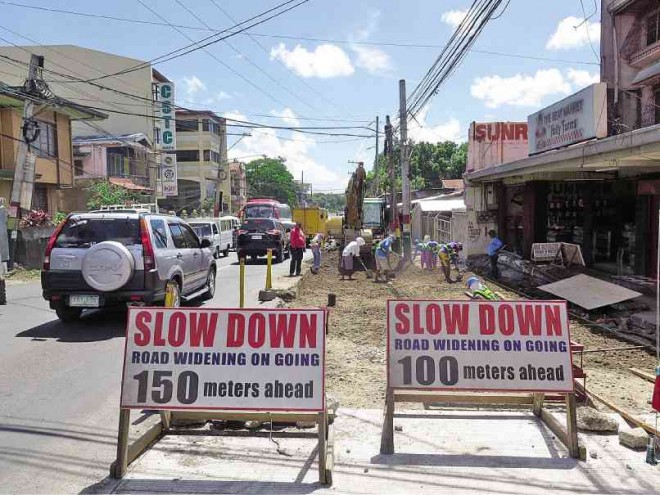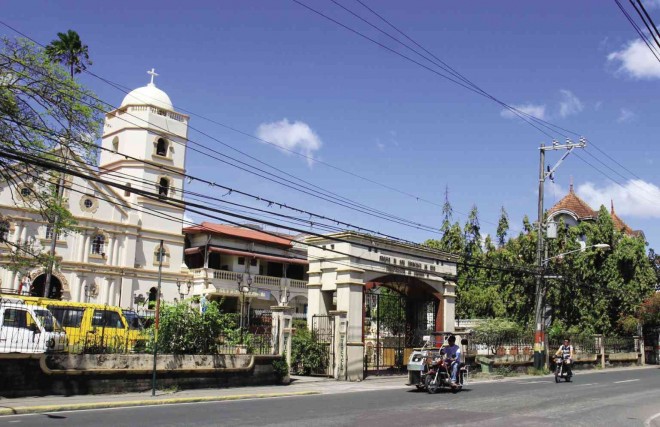Sariaya road project splits residents

THE ROAD-WIDENING project by the Department of Public Works and Highways in Sariaya town proper in Quezon is about 600 meters from a church and a mansion whose frontages and gates are threatened to be demolished. PHOTOS BY DELFIN MALLARI JR.
The mantle of protection from the National Commission for Culture and the Arts (NCCA) apparently is not enough to stop the Department of Public Works and Highways (DPWH) from proceeding with the demolition of heritage structures in Sariaya town.
Danny de Luna, president of the Sariaya Heritage Society (SHC), once again sounded the alarm after they were informed that the DPWH was bent on proceeding with bringing down some heritage structures along its road-widening site despite the “cease and desist order” (CDO) issued on March 18 by the NCCA.
“Whatever their plan is, the DPWH should not circumvent the provisions of the CDO,” De Luna said in a text message to the Inquirer on Wednesday.
On Tuesday afternoon, the Inquirer received text messages that said several heritage houses which are “presumed important cultural properties” (PICP) under Republic Act No. 10066 (National Cultural Heritage Act of 2009) will be demolished in the evening by DPWH workers.
When this correspondent inspected the sites on Wednesday morning, no demolition of PICP structures happened.
Article continues after this advertisement“Our actions on the project were all based on the law, agreement with the local government, SHC and affected residents,” Nestor Cleofas, head of DPWH Quezon’s second engineering district, said over the phone on Wednesday.
Article continues after this advertisementHowever, a DPWH foreman in charge of the road-widening construction said that while they had yet to start digging the other side of the road where the heritage structures are located, they would eventually do so.
“Once we start digging, most probably only the fences and gates of the houses will be affected. But we will replace them,” said the foreman who requested anonymity as he was not authorized to speak to the media.
Divided
Town residents, in random interviews, were divided on the issue.
The owner of a welding shop that would be affected by the third section of the project said he was not opposed to the project. “I don’t mind even if the DPWH will destroy my frontage. This road-widening project is for the benefit of Sariaya,” the owner said.
Edgar Diamante, owner of a 50-year-old store across the street, also posed no objection to the project.
However, the owner of a hardware store on the central part of town said he was strongly against the project. “The DPWH can widen the road outside of town but inside, it’s not welcome,” said Val Sia, whose store and its adjoining residential house are both over 60 years old.
Sia said the DPWH had yet to consult them on the project.
He said his wife tried to record their opposition against the project at the local police station. “But it was not entertained by the police. We don’t know why,” he said.
A retired public school teacher said the road-widening project is just a waste of people’s money.
“Why can’t the DPWH just finish the Sariaya bypass road and other alternative road projects outside of the town?” he argued.

OPPOSITION from the Sariaya Heritage Council has saved the concrete fence and gate of St. Francis of Assisi Parish Church in Sariaya, Quezon from being destroyed by the DPWH’s road-widening project.
‘Important’
On March 18, NCCA board of commissioners chair Felipe de Leon ordered the DPWH “to cease and desist” from implementing the road project “that will potentially affect the Natalio Enriquez heritage house, Sariaya municipal hall and town plaza, St. Francis Assisi Parish church complex and all other deemed/presumed important cultural properties (PICP) in the area” without the coordination of the NCCA and other concerned government cultural agencies like the National Museum and the National Historical Commission of the Philippines.
“Failure to comply with this mandate is a criminal offense under RA 10066,” De Leon said.
According to De Luna, the DPWH plan would also affect 10 other structures that are more than 50 years old and considered “important cultural property.”
Under RA 10066, all structures at least 50 years old are considered important cultural property and are entitled to protection against any form of man-made destruction.
With the strong opposition, the DPWH earlier declared it was abandoning the original plan to widen the entire one-kilometer stretch of the town’s main road. The revised plan would instead only involve the construction of loading and unloading areas in three strategic spots of Sariaya’s main street.
On March 21, Sariaya Mayor Rosauro Masilang convened a meeting at the town hall of local officials, SHC members led by De Luna and Cleofas.
In the meeting, Cleofas declared that the main steel gates and concrete fences of St. Francis of Assisi Church and the adjoining Natalio Enriquez heritage house would be spared from the P16-million project. Both structures were earlier included in the list of structures to be affected by the project.
Public Works Secretary Rogelio Singson also promised to spare the heritage structures from road widening.
The DPWH would instead construct a bypass road outside the town to serve as alternative road for motorists, said Singson before a crowd of Quezon residents when he visited Tiaong town on March 23.
During the March 21 meeting, Cleofas said that instead of demolishing the frontages of St. Francis de Assisi Church and of the Enriquez mansion, the DPWH would create parking spaces by cutting 3.5 meters into the spaces occupied by the public plaza and the municipality-owned sports complex.
Cleofas, on the urging of Masilang, said they would also put on hold the road widening in other sections of General Luna Street until after the Quezon-Batangas ecotourism road is completed.
The Quezon-Batangas road, which was started in 2004, will be completed in September this year. The new road, which bypasses the town proper of Sariaya, aims to serve as alternative road for motorists going to and from Manila and Bicol to address the perennial traffic gridlock inside the poblacion.
Masilang has allowed the DPWH to resume the road widening along the vicinity of the public market provided that the DWPH would put all the necessary traffic and safety signs for motorists and pedestrians.